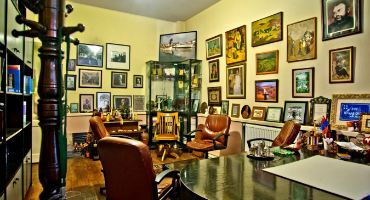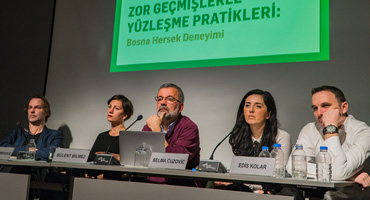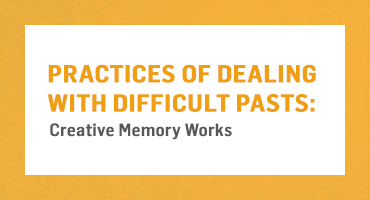“Practices of dealing with difficult pasts: Creative memory works” panel aimed to shed light on the creative and inspiring work of three organizations that conduct activities in the field of memory and dealing with the past. The panel took place on May 21st Monday at the Hrant Dink Foundation and moderated by artist Merve Ünsal. The global networks program coordinator Linda Norris from the International Coalition of Sites of Conscience, director of Cantos Cautivos project Katia Chornik and director of the War Childhood Museum in Bosnia and Herzegovina, Amina Krvavac participated in the panel as speakers.
The panel started with the presentation of Linda Norris on the sites of conscience movement. Norris started her presentation with the story of the establishment of the coalition which backdates to 19 years ago; the coalition was formed by the cooperation of seven different organizations from different geographies with the aim of working in the field of social justice and creating a platform to engage visitors to find solutions for enduring social, economic and political issues. Norris mentioned that the Coalition aims to connect the struggle of the past to the challenges of today in terms of human rights and justice-seeking and informed that the Coalition now consists of 240 members from 60 different countries. The Coalition aims to interpret history through sites, increase public involvement and stimulate dialogue. The coalition runs regional and global networks, runs advocacy and memorialization projects in the field of truth, justice and reconciliation in post-conflict countries and also conducts training for a range of organizations for professional development. Linda Norris finished her presentation by presenting the creative memory works of some member organizations from different parts of the World.
In her presentation, Amina Krvavac told how War Childhood book project developed by Jasminko Halilovic evolved into War Childhood Museum. Kravac emphasized that the lack of the perspective of children is tackled by the project and then by the Museum which was established in 2017. Krvavac told the idea of creating a museum was developed in 2015 following the growing interest for the book project. In two years time, the team succeeded to collect 4000 personal objects, testimonies related to the objects and to conduct 150 hours of oral history recording.
The museum consists of objects, photos, documents and audio-visual materials and permanent & temporary exhibitions. Education programs are also conducted within the work of the museum. Krvavac expressed that rather than constructing a narrative on victimhood, they shift this narrative to the importance of being empowered survivors and highlight the importance of resistance and resilience. Amina Krvavac emphasized that they tell the stories with a lot of dignity. Despite the fact that the war has negative repercussions, the museum sheds light on how children had built up mechanisms of resistance. Amina Krvavac expressed that the museum contributes to talking about the past in a constructive way and to healing.
Director of Cantos Cautivos, Katia Chornik started her presentation by providing a general overview of the historical background of dictatorship in Chile. Chornik talked about the relationship of music with cultural memory, human rights and testimonies. According to Chornik, the detainees had passive and active relation with music and music represented hope and resistance. On the other hand, music was also used as a tool for torture. Chornik mentioned that she conducted a decade-long research in 30 political detention centres, listened to the accounts of victims and perpetrators, collected testimonies and mentioned that many of the individuals had not shared those testimonies with anyone before.
Chornik told that Cantos Cautivos project was developed in cooperation with the Human Rights and Memory Museum in Chile, following the collection of 130 testimonies. Chornik told that the project succeeded to shed light on the difficult past of Chile via music memory.
The panel concluded with a general discussion and Q&A session.





